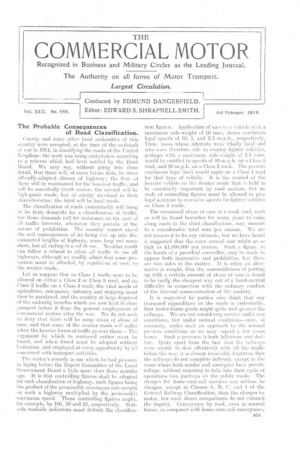The Probable Consequences of Road Classification.
Page 1

If you've noticed an error in this article please click here to report it so we can fix it.
County and some other local authorities of this country were occupied, at the time of the outbreak of war in 1914, in classifying the roads of the -United 1:ingdom: the work was being undertaken according to a scheme which had been settled by the Road. Board. We may say, .without going into close detail, that there will, at s6me future date, be three officially-adopted classes of :highway ; the first of t hese will be maintained for the heaviest traffic, and will be essentially trunk routes; the second will he high-grade roads, but of county standard in their characteristics; the third will be local roads.
The classification of roads undoubtedly will bring in its train demands for a classification of traffic, hut those demands 'call :for resistance on the part of ;ill traffic interests, whenever they partake of the nature of prohibition. The country cannot stand the evil consequences of its being cut up into disconnected lengths of highway, some long and some short, but all ending in a cut de sac. No other result can follow. a refusal to allow all traffic to use all highways, although we readily admit that some protection must be afforded, by regulation of user, to the weaker roads.
Let us suppose that no Class 1 traffic, were to be allowed on either a Class 2 or Class 3 road, and no Class 2 traffic on a Class 3 road; the vital needs of agriculture, commerce, industry and shipping must then be paralysed, and the country at large deprived of the enduring benefits which are now held in close prospect before it from the general employment of commercial motors after the war. We do not seek to deny that there will be some eases of abuse of user, and that sonic of the weaker roads will suffer when the heavier forms of traffic go over them. • The argument by inlich to confound critics must be found, and when found must be adopted without hesitation, and employed at every opportunity by all eoncerned with transport activities.
The writer's remedy is one which he had pleasure in laying before the Expert Committee of the Local Government Board a little more than three months ago. It is that controlling figures shall be adopted for each classification of highway, such figures being the product of the permissible maximum axle-weight OH such a highway multiplied by the perinissibl maximum speed. These controlling figures might, for example, be 100, 50 and 25, respectively. Suitable roadside indicators must delimit the classifica tion figures. Applieation of ours to it vehiele. with a maximum axle-weight of 10 tons, shows maximum legal speeds of 10,5, and '2.5 m.p.h., respectively. Thus, users whose .interests were wholly local and who were therefore able to employ lighter vehicles, perhaps with .a maximum axle-weight of 2.5 tons, Would be entitled to speeds of 10 m.p.h. on a Class 3 road, and 20 m.p.h. on a Class 2 road, The present maximinn legal limit would apply on a Class 1 road for that type of vehicle. It is the control of the heavier vehicle on the -Weaker roads that is held to be essentially important by road makers, but no scale of controlling figures must be allowed to give legal sanction to excessive speeds for lighter vehicles on Class 1 roads.
The occasional abuse of user of a weak road, such as will be found hereafter for many years to' come along roads in the third classiReation, may amount to a considerable total sum 'per annum. We are not prepared to fix any estimate, but we have heard it suggested that the extra:animal cost Might go so high as 11,000,000 per annum. Such a figure, in the hands of a parochial councillor, may be made to appear both impressive and. prohibitive, but there are two sides to the, matter. It is when an alternative is sought, that the reasonableness of putting up with a certain amount of abuse of user is found to be really the cheapest way out of a fundamental difficulty in Connection with the ordinary conduct of the internal communication of the country.
It is suggested by parties who think that any increased expenditure on the roads is undesirable, that motor-borne goods might quite well go over the railways. We are not considering service under war conditions, but under normal conditions—now, of necessity, under such an approach to the normal pre-war conditions as we may expect a few years hence. Such a pretence is both fallacious and shallow. Quite apart from the fact that the railway were unable to deal effectively with all the traffic before the war, it is almost inVariably forgotten that the railways do not complete delivery, except 131 the cases where both sender and consignee have private sidings. without requiring to take into their cycle of operations two journeys in the public roads. The charges for horse-cum-rail services can seldom be cheaper, except in Classes A, B, C, and 1 of the General Railway Classification, than the charges by motor, but such direct comparisons do not exhaust the, inquiry. Conveyance by road, even in. normal times, as compared with horse-cum-rail conveyance,






















